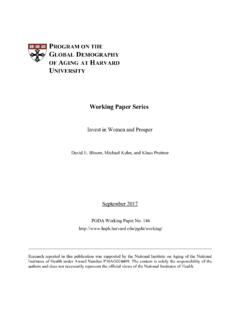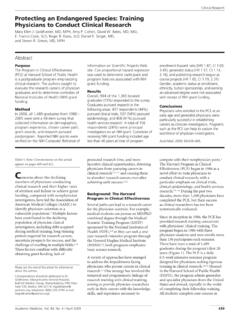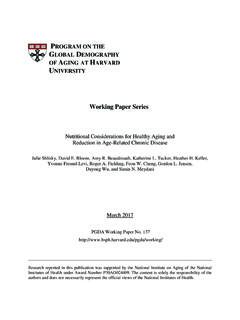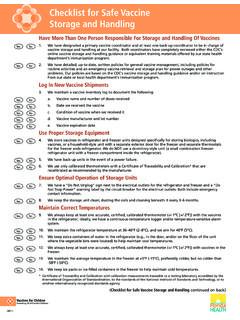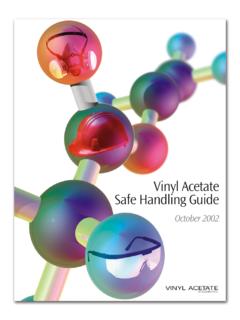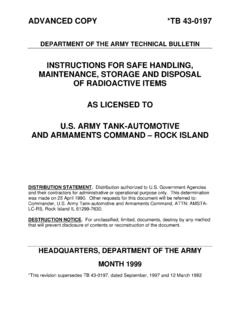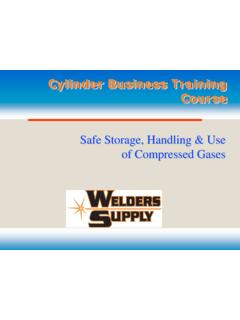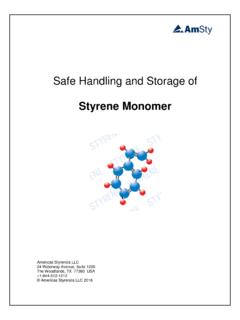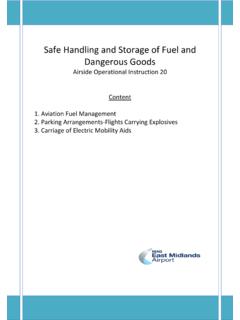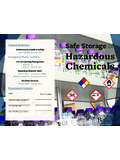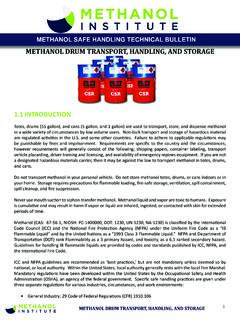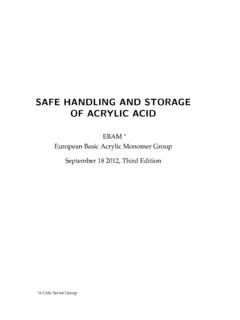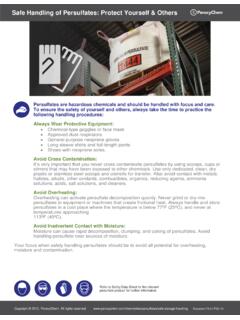Transcription of Safe Handling, Storage, Transport & Use of Compressed Gas ...
1 safe handling , storage , Transport & Use of Compressed Gas & Cryogenic CylindersAirgas Confidential Harvard Safety Training 11/18/15 Anne Powers M: Gases Properties and Hazards Regulator Use and Selection Relief and check valves Flash arrestors & Flow Limit Shut Off Valves storage Questions and AnswersPresentation by Bill Gases Oxygen (Cryogenic/ Compressed ) Nitrogen (Cryogenic/ Compressed ) Carbon Dioxide Propane Hydrogen Air all Air is not the same??? Oxygen/Nitrogen Compressed Mixture2 Hazard Communication Right to Know based on your Chemical Inventory Label primary means of product identification DOT Hazard Class Label or Placard limited information does not address all the hazards Hazard Communication Standard (HCS) requires Pictograms on labels + Product ID, Signal Word, Hazard Statement, Precautionary Statement Container Color should never be used to identify contents Safety Data Sheets (SDS)
2 @ Place to Start SDS Safety Data Sheet Previously known as a MSDS Available at Families Industrial Gases atmospheric - nitrogen, oxygen, argon commodity - helium, hydrogen, carbon dioxide Specialty Gases industrial gases purified to extreme levels rare gases - Ne, Kr, Xe manufactured gases SF6, Halocarbons mixtures not found in nature - 10% O2 / N25 DOT Hazard Classes Most gases act as asphyxiants Some are flammable Some are pyrophoric Some are oxidizers Some are toxic and/or corrosive Some exist as cryogenic liquids A hazard common to all gases.
3 PRESSURE6 Nonflammable Gases Largest volume of cylinders Colorless, Odorless, Tasteless, Non-Irritating NO WARNING PROPERTIES Hazards Pressure 6000 psig Asphyxiant O2 Cryogenic cold Examples - argon, helium, nitrogen7 Reality Hazards of Cryogens Cryogens have all the hazards normally associated with the product at ambient conditions Plus The Hazards Of: Extreme Cold Fog Clouds Large Expansion Ratios 1 volume of Nitrogen liquid = 697 volumes of Nitrogen gas Embrittlement of Materials9 Over-Pressurization Relief Valve Trapped Liquid or Gas 10Va l v e sPressure Relief ValveCheck Valve Check valvesare mechanicalvalvesthat permit gases (& liquids)
4 Flow in only one direction Prevent process flow from reversing AKA one-way directionalvalves Fluid flow in the desired direction opens thevalve, while backflow forces thevalveclosed Ultimately prevent backflow into a process, or into the Airgas cylinder11 Oxidizers The Good gases Oxygen - given to us by doctors when we have trouble breathing Nitrous oxide - laughing gas given to us by dentists as an anesthesia Intentionally inhaled How can these gases hurt us? Oxygen/Oxidizer enrichment Adiabatic heat of compression Systems must be cleaned for oxidizer service12 Flammable Gases The same hazards of nonflammable gas Pressure Asphyxiation Plus Flammability & Explosive impact Common Examples.
5 Acetylene, propane, hydrogen, methane, carbon monoxide + flammable gas mixtures13 Flash Arrestor & Excess Flow Shut Off Designed to prevent flash back of an oxidizer or flammable to the process (or ignition source)_____ Excess Flow Designed from 10 to 3,500 psig Used either between a high-pressure source at the inlet to the pressure regulator or low-pressure delivery line to a process In both applications, this control valve will automatically shut off the delivery of gas if it exceeds a preset limit14 Personal Protective Equipment General Cylinder handling safety glasses, leather gloves, safety shoes System Operations Consult SDS Emergency Operations Consult SDS There is no one piece of PPE that can protect against all hazards!
6 Product Hazard exposure Common sense15 Basic Cylinder handling Always: Wear proper personal protective equipment. leather gloves, safety glasses, safety shoes Restrain the cylinder during storage , moving, use Make sure the cylinder cap is properly installed when the cylinder is not in use. Use a cart when moving cylinders Install outlet seals and cylinder caps for return16 Basic Cylinder handling Never: Drag, roll or slide cylinders Lift cylinders by the cap Use cylinders as rollers Submit to cylinders temperature extremes Strike an arc on a cylinder Allow cylinders to contact electrical circuits Transport cylinders in enclosed passenger vehicles or a car s trunk17 LET IT FALL!
7 !18 Cylinder storage In accordance with CGA pamphlet P-1 Use good inventory control, first in first out Area should be protected from the elements Proper segregation of hazard classes, incompatible products, and fulls and empties Do not store oxygen cylinders within 20 of cylinders containing flammable gases unless they are separated by a 5 + partition with an at least 30 minute fire-resistance rating. 19 storage of Cylinders Cylinders should be stored in approved areas, and marked. (Signs) storage areas shall be prominently posted with the name or hazard class of the gases being stored Empty and Full Cylinders segregated from each other.
8 storage areas should be well ventilated, dry, and protected from extreme temperatures.(>-20 F, <125 F) Cylinders should be secured, both when In Use and In storage . Never store cylinders near a source of ignition or heat such as furnace or water heat Valves on all cylinders not-in-use must be kept closed and protected by caps. The bottoms of cylinders should also be protected against rusting by storing on grating, concrete, or well drained locations20 CGA Connections Cylinder CGA Oxygen 540 Nitrogen 580 Helium580 Argon580 Carbon Dioxide320 Hydrogen 350 (left hand) (hash marks)
9 Determine use operate at 2/3 of scale for the regulator21 Right Hand = ClockwiseFitting is smooth No V-GrooveLeft Hand = Counter-clockwiseWrench flats are not smooth - with V-GroovePressure22 Pressure RegulatorsRegulators , not flowRegulator for PressureFlowmeter for Flow23 The primary purpose of a regulator is to reduce pressure gas from a higher pressure to a lower use or application pressureHow accurately the pressure is held depends on many variables from regulator design, supply source, physics of the gas, to flow rates2/10 Purpose of a Regulator24 Cylinder regulators Attaches directly to a cylinder Typically rated to 3500 psi Available in single and two stage Body design Forged Bar Stock Multiple body and material available Brass Stainless steel Hastelloy Multiple Diaphragm material Elastomeric Metallic25 Hand tight the regulator Tighten with a proper non sparking wrench Leave at a 45 degree angle Do not stand in front of the regulator Do not stand behind the regulator Do not stand on the regulator never a need for you to use Teflon tape Attaching
10 The Regulator After opening the valve a half turn, continue to slowly fully open the cylinder valve Apply an approved leak solution to the connection to test for any leaks The regulator may now be adjusted to the correct pressure Note: the pressure will be different in the static and flowing state, set the pressure accordingly. Open the outlet valve and the process is now Check valve CGA Most critical component of the modern gas delivery system Maintains the system under positive pressure Minimizes the amount of air that can enter the systemCorrect CGA nipple type is the most important on high purity Analytical Systems28 Nothing is more important SAFETY!
